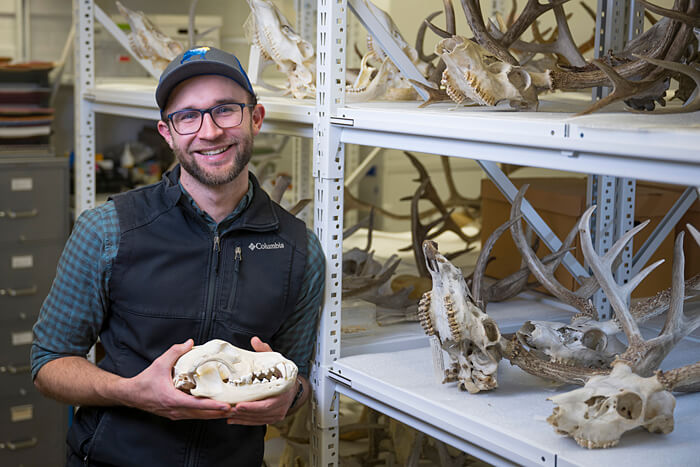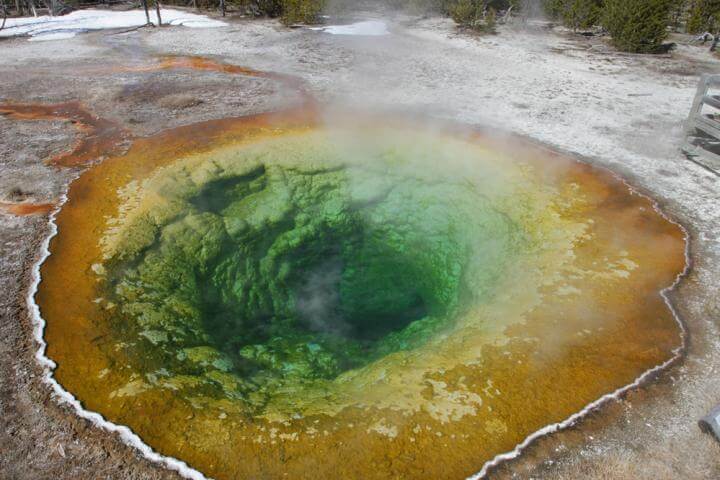MISSOULA, Mont. — What’s going on at Yellowstone National Park? Researchers have discovered that local wolves are carrying strange parasites which make the predators more likely to take risks. At the same time, a separate study has found that there’s even more liquid magma hidden under the Wyoming park’s ancient supervolcano — sparking renewed fears of a future eruption.
The first study, conducted by researchers at the University of Montana, found that this common parasite among cats can literally alter the carrier’s brain. In this case, it turns wolves into risk-takers and makes them more likely to break away from their groups and become pack leaders elsewhere in Yellowstone.
1 in 4 Yellowstone wolves carry brain-altering parasite
The single-celled creature named Toxoplasma gondii is also known as the “mind-control parasite.” Scientists say the bug “prefers” to live in cats and spreads through spore-packed oocysts in their feces.
T. gondii is capable of infecting all warm-blooded mammals. Previous studies have shown that it can make people appear more attractive to others, but it may also increase the risk that carriers develop a rare form of brain cancer.
During their research, wildlife biology doctoral student Connor Meyer and the team tested the blood of 243 wolves in Yellowstone for T. gondii antibodies. They found that more than 27 percent were infected with the parasite.
Moreover, the study finds that infected Yellowstone wolves were 11 times more likely to disperse from their original pack, a very risky choice for wolves. They were also 46 times more likely to become a pack leader.
So, who’s infecting the wolves in Yellowstone? Just like T. gondii can infect humans through undercooked meat, researchers say wolves in Yellowstone are likely encountering the parasite while eating elk — their main source of food.
“Eventually we found the most significant predictor of infection with wolves was when their range overlapped areas with high mountain lion density,” Meyer says in a university release. “So, with no elk testing positive, we hypothesized they were getting infected directly by cougars.”
The study is published in the journal Communications Biology.

Supervolcano closer to eruption than scientists thought?
Meanwhile, geologist Ross Maguire from the University of Illinois Urbana-Champaign and an international team found that the Yellowstone supervolcano in northwest Wyoming may be even more volatile than scientists have previously suspected. Their study revealed significantly more liquid magma under the surface.
The revelation could help geologists estimate when the next major eruption will occur. Luckily, the team says finding more magma doesn’t necessarily mean the supervolcano is more likely to erupt any time soon.
“Although our results indicate that Yellowstone’s magma reservoir contains substantial melt at depths that fueled prior eruptions, our study does not confirm the presence of an eruptible body or imply a future eruption,” Maguire and the study authors write in the journal Science.
Researchers used a newly developed tomographic imaging technique to examine seismic wave recordings at the Yellowstone volcano, taken between 2000 and 2018. Based on the speed of the waves at different depths, the team estimates that the “magma reservoir” beneath Yellowstone has a partial melt fraction of 16 to 20 percent. Previous studies have estimated that only 10 percent of the magma under Yellowstone is liquid.
To put that into context, geologists believe that a volcanic eruption takes place when the amount of liquid magma sits between 30 and 50 percent. While that sound like good news for the United States right now, the team notes they can’t rule out missing other pockets of liquid magma in their scans.
“The melt fraction we estimated is substantially lower than what would be expected if a large fraction of the Yellowstone reservoir were in the eruptible stage of its life cycle,” the researchers conclude. “However, the presence of small subset volumes of concentrated silicic melt cannot be ruled out.”


So how are the wolves being infected? Are they eating the cougar feces?
Gotta be cougar shit
How did they find that the parasite makes you more attractive? That is kind of odd.
How does the parasite look
I can’t help but notice the negative impact the stories I just read about here have. From the horrible things being said about American luxury cars to the wolves carrying parasites in their brains causing abnormal behavior, not to mention finding more liquid magma under Yellowstone. Wow! Where do we start trying to believe the world is still a great place to be. That said these are all things I love about life. Or should I say I did love? Yellowstone National Park has long been one of my favorite places to be. I’ve been going there since the 70s and love it more each time I go. Well not so much in 1988 when my brother and I drove through while it was burning with wildfires over 80% of the park. What wasn’t burning already had. And wolves are one of nature’s most incredible mammals that I’ve always been in awe of. And being a Gearhead all my life with a life long passion for the American auto industry, especially our beautiful world famous large luxury cars from each of the Big Three, it’s very discouraging to believe we can continue to hear these things without thinking that life as we have known it to be isn’t about end little by little. I’m 67 years old and now hope I won’t live long enough to see it all end the way it’s headed. We better focus on what we can do to fix everything. Oh, by the way, I forgot to include the 20 year drought that’s killing the beautiful American West. I hope I will be able to sleep tonight with all this in my head. It makes me feel the urgent need to get in the car and visit Yellowstone, Lakes Powell and Mead and all their glory before it’s all gone. With Powell and Mead at 25% capacity, I better drive fast!
Get in the car and go there. I am a Montana native, who has extended family buried under one of Yellowstone’s earthquakes. FYI: Strange animal behavior? In the Bible, at the end as we know it, animals turn on humans to kill them. I have warned neighbors who have small children when wolves were traversing our yards in plain sight, and fighting with my giant breed German Shepherd.
Is it a sexually transmitted parasite?
It seems lately like house cats are also getting sick with the same problems of one another. And it’s causing them to also ack strange, get bumps on their backs and it looks and feels bad if you pet them seems it would be painful. These cats tend to want to stay outside more then inside. And they can stay out longer periods of time, without eating or drinking it seems . Yes maybe they are hunting of course but not certain if they are or just off and asleep? or who really knows . But when the finally come indoors their quick to eat and cry and beg annoyingly to want right back out . Also if they are in and using a litter box they will eat cat litter. I think it’s a disease called pica and it comes from parasites. Maybe carried by flees ticks or worms . But strange that hearing this alot lately more and more . Wild animals usually stay in the wild and hunt but some stray to cities and towns and may feed off trash and pass it on that way or just from bugs and parasites,I hope they find what’s causing theses things that are happening maybe related or have nothing at all to do with each other but it’s good if people help to try to figure something out or talk about different behaviors from the wild and domesticated ones.
Parasites, lymelites, mobalites, hitites, what else?. Is affecting our animals on this earth….
The beginning of the zombie apocalypse has begun.